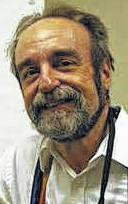
Over the past several weeks, I discussed Galileo’s contribution to the 17th century conflict between two world views — the old view that Earth was at the center of the cosmos and the burgeoning belief that the sun was at the center.
However, the story’s real hero is the mystical mathematician Johannes Kepler.
He got his humble academic start as a poorly paid teacher at the Protestant gymnasium (our “high school”) in Gratz, Austria. On July 9, 1595, he experienced the first of two great realizations that struck him with almost spiritual force.
Prematurely born, Kepler was a sickly child. His father left his impoverished family when little Johannes was 5 years old. His mother, who was later accused of witchcraft, made an insufficient living as an herbalist and healer.
Still, young Kepler loved stargazing and astronomy. However, a life-threatening bout with smallpox left him with weak vision and crippled hands. He would never be an observational astronomer.
Fortuitously, young Johannes was a skilled mathematician. He was also something of a magnificent oddball.
What was a poor and disabled child with a wondrous gift to do in a society that mostly left its poor children out of the advanced educational system?
In those days, Europe’s Christian institutions, both Roman Catholic and protestant, controlled the educational system. Those institutions sought theological soldiers to help maintain their sway over the population.
In Germany, they offered scholarships to poor boys (and, yes, they were all male) through the local duchies that controlled a given area.
In 1589, Kepler was offered a ducal scholarship to the Lutheran seminary at the University of Tübingen with the expectation that, upon graduation, he would become a Protestant minister or schoolteacher.
While at the seminary, he used his mathematical skills to become a skilled astrologer. Many of his fellow students asked him to cast their horoscopes.
He soon attached himself to the university’s brilliant mathematics professor, Michael Maestlin, one of the distressingly few proponents of the Copernican notion that the sun — and not the Earth — was at the center of the cosmos.
Kepler adopted the sun-centered hypothesis through Maestlin and his heavily annotated copy of Copernicus’s “On the Revolutions of the Celestial Spheres,” published half a century earlier. According to Copernicus, the planets orbit the sun. Above the planets is the fixed celestial sphere of stars.
Supporting Copernicus was a dangerous business. All Christian religions condemned the theory and sometimes harshly punished those who accepted it. He secretly taught Copernican theory to Kepler but was reluctant to express his beliefs publicly.
For Kepler, the Copernican system amounted to divine revelation. He saw a reflection of God’s plan for the world in the system. By the early 1590s, Kepler had decided to take Copernicus’ educated guesswork about the structure of the cosmos and eventually provide a rigorous mathematical proof.
However, the Bible seemed to put Earth at the center. Kepler struggled in vain to show that some Biblical passages implied that the sun was at the center.
During his college years, he developed his mystical vision of the universe. His language is both mathematical and deeply religious. To see into the order of the universe was to see into God’s thoughts as he created it.
He wrote, “Before the origin of things, geometry was coeternal with the Divine Mind.” Geometry became a reflection of the orderliness of the divine mind. In effect, God had embodied himself in the structure of the cosmos.
God created the universe according to an intelligent plan. Humans could discern that plan through God’s greatest gift to humans — the power of reason.
And so it was that Kepler stood before the blackboard on that fateful day in July 1595. As he taught a mathematics class to his students, he drew an equilateral triangle within a circle and another circle within the triangle.
Here was geometric perfection. The circles were perfect in their symmetry. The triangle had equal sides and angles and touched both circles three times.
The triangle perfectly divided both circled into thirds. The inner circle perfectly divided the sides of the triangle into perfect halves.
Kepler spent the rest of his days attempting to translate that perfection into a system that reconciled God’s geometric mind with the structure of God’s universe.
More on that next week.
Tom Burns is the former director of the Perkins Observatory in Delaware.

